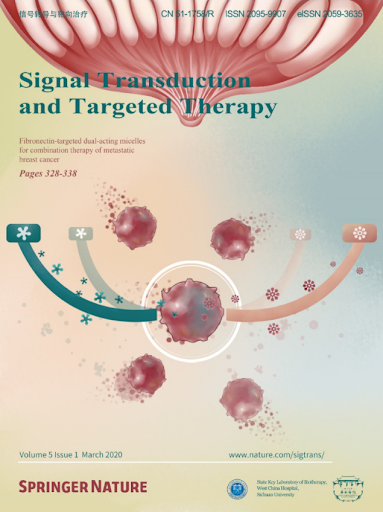骨髓B淋巴生成加速早期脑淀粉样蛋白病理。
IF 52.7
1区 医学
Q1 BIOCHEMISTRY & MOLECULAR BIOLOGY
引用次数: 0
摘要
骨髓是协调大脑免疫的造血细胞的主要来源。然而,阿尔茨海默病(AD)患者骨髓造血系统的改变及其对神经炎症和大脑β-淀粉样蛋白(Aβ)病理的潜在影响尚不清楚。在这里,我们报道了Aβ在AD患者的骨髓中积累,并特别集中在中枢神经系统周围的骨骼中。在5 × FAD和APP/PS1小鼠(两种典型的小鼠AD模型)中,Aβ在颅骨骨髓中积累,先于大量的大脑Aβ沉积。流式细胞术和细胞跟踪分析表明,这些AD小鼠在B淋巴系中表现出增强的骨髓造血功能,特别是年龄相关B细胞(abc)的增加,伴随着这些细胞向脑实质输出的增加。此外,在IL-6敲除小鼠中颅内注射Aβ发现,Aβ通过IL-6信号传导促进B淋巴细胞的生成,特别是abc。脑室内注射ABCs后的单细胞测序分析,结合体外小胶质细胞培养研究,表明骨髓来源的ABCs直接增强了小胶质细胞的反应性,最终加剧了AD模型中的Aβ神经病理和认知缺陷。值得注意的是,阻断IL-6R可限制骨髓中的b细胞活性和abc,延缓脑Aβ病理并改善认知。我们的研究结果揭示了骨髓源性B细胞可能参与两种小鼠AD模型的早期脑淀粉样蛋白病理,并提示这些B细胞可能作为AD患者的潜在治疗候选者。本文章由计算机程序翻译,如有差异,请以英文原文为准。
Bone marrow B lymphopoiesis accelerates early cerebral amyloid pathology.
Bone marrow is a major source of hematogenous cells that orchestrate brain immunity. However, alterations in the bone marrow hematopoietic system in patients with Alzheimer's disease (AD) and their potential impacts on neuroinflammation and cerebral β-amyloid (Aβ) pathology remain unknown. Here, we report that Aβ accumulates within the bone marrow of patients with AD and is particularly concentrated in the central nervous system-surrounding bones. In 5 × FAD and APP/PS1 mice, two classic mouse AD models, Aβ accumulates within the skull bone marrow prior to substantial cerebral Aβ deposits. Flow cytometry and cell tracking analyses demonstrated that these AD mice exhibit enhanced bone marrow hematopoiesis in B lymphoid lineages, specifically an increase in age-associated B cells (ABCs), accompanied by heightened output of these cells into the brain parenchyma. Furthermore, intracranial Aβ injection into IL-6 knockout mice revealed that Aβ promotes B lymphocyte generation, particularly ABCs, via IL-6 signaling. Single-cell sequencing analysis following intracerebroventricular ABCs injection, combined with in vitro microglial culture studies, demonstrated that bone marrow-derived ABCs directly augment microglial reactivity, ultimately exacerbating Aβ neuropathology and cognitive deficits in AD models. Notably, blockade of IL-6R restricts B-cell activity and ABCs in the bone marrow, delays cerebral Aβ pathology and improves cognition. Our findings reveal the potential involvement of bone marrow-derived B cells in the early cerebral amyloid pathology in two mouse AD models and suggest that these B cells may serve as potential therapeutic candidates for patients with AD.
求助全文
通过发布文献求助,成功后即可免费获取论文全文。
去求助
来源期刊

Signal Transduction and Targeted Therapy
Biochemistry, Genetics and Molecular Biology-Genetics
CiteScore
44.50
自引率
1.50%
发文量
384
审稿时长
5 weeks
期刊介绍:
Signal Transduction and Targeted Therapy is an open access journal that focuses on timely publication of cutting-edge discoveries and advancements in basic science and clinical research related to signal transduction and targeted therapy.
Scope: The journal covers research on major human diseases, including, but not limited to:
Cancer,Cardiovascular diseases,Autoimmune diseases,Nervous system diseases.
 求助内容:
求助内容: 应助结果提醒方式:
应助结果提醒方式:


